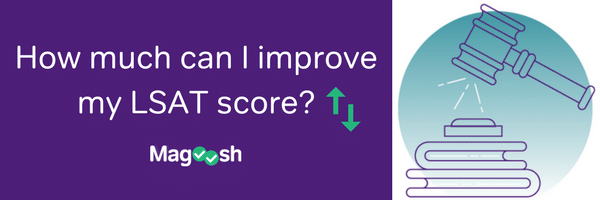
The answer to the question “How much can I improve my LSAT score?” depends largely on where you’re starting out. As a general rule, the higher your starting score, the smaller the point gains you’re likely to see. In other words, someone starting with a practice test score of 168 may not be able to raise his or her score by as much as someone starting out with a practice test score of 146.
Why? First, because there just aren’t as many points to be gained for someone with a 168. Second, because the competition at the 168 level is much tougher than the competition at the 146 level. Remember that you’re being scored against other test-takers, so it’s not about simply getting one more question right. Instead, it’s about getting one more question right than everyone else.
While it’s difficult to predict how much your score will increase with practice, it’s important to set reasonable goals to track your progress and guide your testing strategy. That’s what the rest of this post will help you do.
A Step by Step Approach
One of the most common mistakes I’ve seen students make in the past is setting too high an initial goal and failing to break it down into manageable pieces. Think of goal-setting as a step by step process. Set a goal for each step, master the skills necessary to take that step, and if you succeed at doing so, set a new goal and proceed. This allows you to focus on a smaller number of skills at any given point in your prep, and it provides a sense of accomplishment if you’re able to meet your first goal and move on to the next one.
On the contrary, setting a single, overly ambitious goal at the outset and failing to meet it usually results in discouragement. That’s a disruptive emotion on a test as mentally draining as the LSAT. You don’t have time for that.
What is the First Step?
To determine a reasonable score goal for your first step, take a timed, full-length practice test. When you’re done, count how many questions you answered incorrectly in each section. Divide that number in half, and that’s how many more questions in each section you’ll be trying to answer correctly in order to meet your first goal.
Example: Charlie takes his first practice test for the current LSAT (note: the LSAT is changing in August 2024). His results are below:
| Section | Number of Questions | Correct Answers | Wrong Answers | Goal |
|---|---|---|---|---|
| Logical Reasoning | 25 (varies 24-26) | 18 | 7 | 22 correct, 3 incorrect |
| Analytical Reasoning | 23 (varies 23-24) | 17 | 6 | 20 correct, 3 incorrect |
| Reading Comprehension | 27 (varies 26-28) | 15 | 12 | 21 correct, 6 incorrect |
Charlie missed a total of 7 Logical Reasoning questions, so his initial goal for Logical Reasoning is to cut that in half. He’ll answer 4 more LR questions correctly and miss a total of 3.
The same was done with his Analytical Reasoning and Reading Comprehension scores.
In total, Charlie’s first goal is to bring his number of incorrect answers from 25 to 12. Looking at an average score conversion table, that would change his scaled score from a 157 to a 166. That is a challenging yet reasonable goal for Charlie’s LSAT prep.
What is the Second Step?
After a couple weeks of regular practice, Charlie is probably ready to take another timed, full-length practice test (want to know how long that is? Take a look at our blog post). At this point in his prep, it’s highly unlikely that Charlie will meet his first goal and score 166. In fact, scores on second practice tests often drop or stay flat as test takers try to adjust to all the material they’ve been learning for the first time. Over the next couple practice tests, Charlie should be aiming to cover about ⅓ to ½ of his goal, and end up somewhere around 160-161.
If he succeeds at this, he’s well on his way to reaching his goal and may even do so 1-2 more practice tests down the road. If he doesn’t make any progress, that’s also okay. It just means he might need a bit more time to reach that first goal.
Regardless, let’s say that Charlie does in fact meet his goal a few practice tests down the road. It’s probably time for Charlie to take himself out for dinner and a movie, and then set a new goal. He’ll do that exactly the same way he set his first goal.
Here’s how Charlie’s doing now:
| Section | Number of Questions | Correct Answers | Wrong Answers | Goal |
|---|---|---|---|---|
| Logical Reasoning | 25 (varies 24-26) | 21 | 4 | 23 correct, 2 incorrect |
| Analytical Reasoning | 23 (varies 23-24) | 20 | 3 | 21-22 correct, 1-2 incorrect |
| Reading Comprehension | 27 (varies 26-28) | 20 | 7 | 23-24 correct, 3-4 incorrect |
Notice that Charlie didn’t hit the exact numbers he set as his goal, but he’s incredibly close on all of them and his homework supports that.
According to these new numbers, Charlie’s scaled goal would change from 166 to roughly 171. That’s an extremely ambitious goal for Charlie, but if he’s made his way up to the mid 160’s from 157, he’s proven that he’s up to the challenge.
Is There Always a Second Step?
Absolutely not.
In fact, the example above is unrealistic for most students. Moving from a 157 to a 171 is an exceptional accomplishment, and while a number of students manage it every year, a much larger number only make it part of the way there. Even in Charlie’s case, we don’t know if he ever actually obtains that 166, let alone the 171. It is simply the goal he sets for himself after achieving his first goal.
The step by step approach is designed to help you determine a reasonable—not an easy—initial goal for your LSAT prep. Most students are challenged to reach the goal they set for their first step, but it’s a healthy challenge. Typically, by adjusting your pacing and changing your response to the most challenging questions on the test, you are able to collect most of the points you need to reach your goal, but the last few points are often elusive. Obtaining those last few points requires digging deeper into concepts and question forms that are tripping you up, and finding a standardized method to approach them that will help you avoid traps and mistakes.
About half of the skills you develop during test prep should be about pacing and prioritizing; the rest should be about exam content. The higher your starting score, the more important that latter half will be to your prep. The lower your starting score, the more important it is to master the fundamentals (timing, question type, when to guess, etc…) before you dive into more advanced concepts.
What if I Never Reach My First Goal?
That’s the reality for most students prepping for the LSAT. Try to ignore the wild success stories you read online or hear from friends. Those are exceptions to the rule, and unless you’re the type who finds motivation from successes like those, they’re likely to discourage you.
If you haven’t met your first goal yet, the answer is simple: set a deadline to preserve your sanity, and keep trying. Give yourself at least 3 months to study for the LSAT. Six months is also great, but if you’re prepping for longer than that, you better have a good reason (demanding job that limits your study time, illness, current undergrad with more than a year before graduation, etc…).
Pick an LSAT test date that is a healthy distance into the future (picking the right test date for you is an important part of the process), and prepare for it. If what you’re doing now isn’t working, try a different book, course, or tutor, but devote yourself wholly to whatever approach you choose. Bouncing around too much from one method to another will leave you half prepared in a number of ways, and not fully prepared in any one.
And remember, LSAT prep is about improving your own performance and doing the best that you can do. Don’t judge yourself according to percentiles and admissions statistics. Instead, assess your progress based on where you started out and how far you’ve come. That’s the only metric entirely within your control.






Leave a Reply